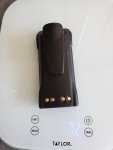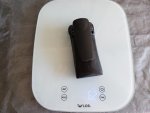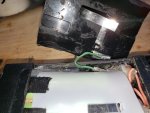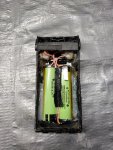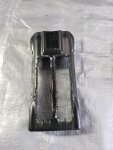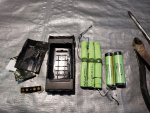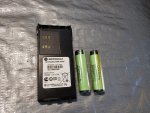Lets go into some review of why I started this project.
I have few HT750 and HT1250 radios that I love to use. My biggest frustration is the OEM designed Battery pack. It does not last long after full charge, its expensive to buy replacements, there are bunch of aftermarket batteries with questionable cell quality and some claim outrageous capacity that is not realistic.
After doing testing and measurements of the actual radio power requirements I came to a simple conclusion that OEM based NiMH AAX6 based battery pack does not work well with radio to my expectations, in fact it even might limit radio’s full potential transmitter performance (more on why that is below).
So, what’s wrong with OEM (or aftermarket) HT750/HT1250 LM9008N battery? Let’s first look at actual power consumption of the radio itself.
At Hi Power Output, radio measured 1.75A @ 8V, its 14W of battery supplied power required.
In Low Output, Radio measured 1.25A @ 8V, its 10W of power needed. There may be some error in those measured numbers as digital multimeter was affected by RF energy emitted from radio.
What’s wrong with those numbers?
My general Rule of Thumb for AA rechargeable cells is this: Maximum continues current shall not exceed 1A for cells to function adequately. HT750 need almost 2A continuous with 6 AA cells in series! Simply put it: current draw is too high for 6 NiMH AA cells connected in series. NiMH rechargeable cells have higher internal resistance than Li-Ion or NiCd cells, that causes them to heat up with high current draw, wasting capacity into heat but more importantly to radio performance- to drop voltage output (and therefore limit the Tx power available) with such high current requirement from radio. That aspect is also cell chemistry dependent and varies with different cell capacity and between manufacturers which makes it frustrating to have consistency between different packs.
It’s also plainly obvious that battery pack CAN NOT meet radio TX Power demand when backlit LCD screen on HT1250 dims with push of transmit button on fully charged pack. That is an indication of voltage drop at power supply, meaning battery can’t maintain constant voltage with TX power needed. I suspect NiCd original battery packs can provide 1.75A of continues current but at cost of fast discharge due to limited capacity (something like 1200mAh or lower on original OEM packs) and memory effects during usage that will limit cell capacity even further. I don’t own original NiCd Motorola pack to test power capability for comparison, but theoretically NiCd do provide higher currents than NiMH cells due to lower internal resistance and its possible that original Motorola NiCd packs did meet Radio power needs when radio was released (I certainly hope so, otherwise Motorola does not know what they are doing )
)
I also don’t have tools at home to assess direct impact on transmitter RF output degradation with NiMH battery, but it must be there by laws of physics and therefore real-world degradation of radio performance is present (I mean transmitter power is lower than designed).
OK, so how do we get out of this mess with old and heavy NiCd and NiMH aftermarket batteries made for HT750/HT1250 and create the Ultimate Power Pack for long reliable operation and full radio potential???
I decided to go with tried and true Li-Ion cells that I get on Ebay, made by PANASONIC. Of course, I am talking about 18650 cells that power among others things like….TESLA cars. We will need 2 of them connected in series to get us to 8.4VDC battery (4.2V each).
Those cells have 3400mAh capacity (by far capacity exceeds anything in HT750 pack you can buy now) and can provide huge current draw (easily above 10A), Weight wise 2X18650 much lighter than 6XAA!
By The Way , I use Panasonic made in Japan cells because they are simply affordable and best cell at this time you can buy.
Don’t believe other 18650 cells on Ebay claiming 5000mAh or even 10000 mAh capacity. It’s a scam. Biggest Li Ion cell producing company like Panasonic struggles to go above 3400mAh, not to mention no-name brands claiming 5000mAh and more is unrealistic to be polite.
You also can find lots of articles on Google testing different cells and explaining scam advertising.
I have extensively used Panasonic 18650 cells myself in replacing Laptop battery cells, Blue Tooth Speaker batteries, upgrading Hi Power Flashlights from AA to Li Ion to drastically improve operational life and performance of all sorts of devices.
Now it’s time to boost MOTOROLA HT750/HT1250 to a new unseen level of performance, make it lighter and give your old friend radio an unbelievable performance boost on single charge compared to any old pack with six AA cells. It will be like taking old beat up Pontiac Fiero and turning it into TESLA or something like that!
The process to replace AA to Li-Ion cells will require skills using cutting tools, soldering, understanding of electronic circuits and Li-Ion cell safety and fiberglass laying process, work with fiberglass and epoxy resins. It was easy to do because I had most of what I needed on hand and experience to do such a job. 1 Battery pack conversion takes about5 days few hours of work each day mostly because of drying time for fiberglass, epoxy and paint.
I used 2 charging ports -one for each cell. This way you can charge 2 cells individually and you will maximize each cell every charge to get max performance out of your pack.
Word of caution: Li Ion batteries can and do catch on fire if short circuited. Therefore, if you are not comfortable or not familiar with proper circuit protection techniques that will prevent short circuit on unprotected Li Ion cells that can result in potential fire, I encourage to use PROTECTED CELLS that are sold on Ebay with electronic circuitry attached to each cell end will interrupt current flow if short circuit happen to occur. Protected cells are a bit longer physically and slightly more expensive than unprotected, but it will give you piece of mind and safety. I used both types in my HT radio upgrades, but unprotected will require correct fusing and therefore extra components and knowledge how to do that correctly.
I used only positive and Negative power tabs on battery pack for Li-Ion conversion. Left middle tab unused. Middle tab is used by radio for battery indicator on HT1250 and LED battery state display on HT750 (if programmed) Leaving it unused will make those functions disabled. But don’t worry, your radio will still emit annoying double beep when voltage drops to about 6V, telling you to recharge without that center tab used.
Below some pictures of conversion and final result.
And the result feels like you attached a mini “Nuclear Reactor” to your beloved HT750/HT1250. That will bring you endless satisfaction with results of your efforts. New battery pack whole Ounce lighter than old 6AA cell pack was! With 3 times capacity!
I have few HT750 and HT1250 radios that I love to use. My biggest frustration is the OEM designed Battery pack. It does not last long after full charge, its expensive to buy replacements, there are bunch of aftermarket batteries with questionable cell quality and some claim outrageous capacity that is not realistic.
After doing testing and measurements of the actual radio power requirements I came to a simple conclusion that OEM based NiMH AAX6 based battery pack does not work well with radio to my expectations, in fact it even might limit radio’s full potential transmitter performance (more on why that is below).
So, what’s wrong with OEM (or aftermarket) HT750/HT1250 LM9008N battery? Let’s first look at actual power consumption of the radio itself.
At Hi Power Output, radio measured 1.75A @ 8V, its 14W of battery supplied power required.
In Low Output, Radio measured 1.25A @ 8V, its 10W of power needed. There may be some error in those measured numbers as digital multimeter was affected by RF energy emitted from radio.
What’s wrong with those numbers?
My general Rule of Thumb for AA rechargeable cells is this: Maximum continues current shall not exceed 1A for cells to function adequately. HT750 need almost 2A continuous with 6 AA cells in series! Simply put it: current draw is too high for 6 NiMH AA cells connected in series. NiMH rechargeable cells have higher internal resistance than Li-Ion or NiCd cells, that causes them to heat up with high current draw, wasting capacity into heat but more importantly to radio performance- to drop voltage output (and therefore limit the Tx power available) with such high current requirement from radio. That aspect is also cell chemistry dependent and varies with different cell capacity and between manufacturers which makes it frustrating to have consistency between different packs.
It’s also plainly obvious that battery pack CAN NOT meet radio TX Power demand when backlit LCD screen on HT1250 dims with push of transmit button on fully charged pack. That is an indication of voltage drop at power supply, meaning battery can’t maintain constant voltage with TX power needed. I suspect NiCd original battery packs can provide 1.75A of continues current but at cost of fast discharge due to limited capacity (something like 1200mAh or lower on original OEM packs) and memory effects during usage that will limit cell capacity even further. I don’t own original NiCd Motorola pack to test power capability for comparison, but theoretically NiCd do provide higher currents than NiMH cells due to lower internal resistance and its possible that original Motorola NiCd packs did meet Radio power needs when radio was released (I certainly hope so, otherwise Motorola does not know what they are doing
I also don’t have tools at home to assess direct impact on transmitter RF output degradation with NiMH battery, but it must be there by laws of physics and therefore real-world degradation of radio performance is present (I mean transmitter power is lower than designed).
OK, so how do we get out of this mess with old and heavy NiCd and NiMH aftermarket batteries made for HT750/HT1250 and create the Ultimate Power Pack for long reliable operation and full radio potential???
I decided to go with tried and true Li-Ion cells that I get on Ebay, made by PANASONIC. Of course, I am talking about 18650 cells that power among others things like….TESLA cars. We will need 2 of them connected in series to get us to 8.4VDC battery (4.2V each).
Those cells have 3400mAh capacity (by far capacity exceeds anything in HT750 pack you can buy now) and can provide huge current draw (easily above 10A), Weight wise 2X18650 much lighter than 6XAA!
By The Way , I use Panasonic made in Japan cells because they are simply affordable and best cell at this time you can buy.
Don’t believe other 18650 cells on Ebay claiming 5000mAh or even 10000 mAh capacity. It’s a scam. Biggest Li Ion cell producing company like Panasonic struggles to go above 3400mAh, not to mention no-name brands claiming 5000mAh and more is unrealistic to be polite.
You also can find lots of articles on Google testing different cells and explaining scam advertising.
I have extensively used Panasonic 18650 cells myself in replacing Laptop battery cells, Blue Tooth Speaker batteries, upgrading Hi Power Flashlights from AA to Li Ion to drastically improve operational life and performance of all sorts of devices.
Now it’s time to boost MOTOROLA HT750/HT1250 to a new unseen level of performance, make it lighter and give your old friend radio an unbelievable performance boost on single charge compared to any old pack with six AA cells. It will be like taking old beat up Pontiac Fiero and turning it into TESLA or something like that!
The process to replace AA to Li-Ion cells will require skills using cutting tools, soldering, understanding of electronic circuits and Li-Ion cell safety and fiberglass laying process, work with fiberglass and epoxy resins. It was easy to do because I had most of what I needed on hand and experience to do such a job. 1 Battery pack conversion takes about5 days few hours of work each day mostly because of drying time for fiberglass, epoxy and paint.
I used 2 charging ports -one for each cell. This way you can charge 2 cells individually and you will maximize each cell every charge to get max performance out of your pack.
Word of caution: Li Ion batteries can and do catch on fire if short circuited. Therefore, if you are not comfortable or not familiar with proper circuit protection techniques that will prevent short circuit on unprotected Li Ion cells that can result in potential fire, I encourage to use PROTECTED CELLS that are sold on Ebay with electronic circuitry attached to each cell end will interrupt current flow if short circuit happen to occur. Protected cells are a bit longer physically and slightly more expensive than unprotected, but it will give you piece of mind and safety. I used both types in my HT radio upgrades, but unprotected will require correct fusing and therefore extra components and knowledge how to do that correctly.
I used only positive and Negative power tabs on battery pack for Li-Ion conversion. Left middle tab unused. Middle tab is used by radio for battery indicator on HT1250 and LED battery state display on HT750 (if programmed) Leaving it unused will make those functions disabled. But don’t worry, your radio will still emit annoying double beep when voltage drops to about 6V, telling you to recharge without that center tab used.
Below some pictures of conversion and final result.
And the result feels like you attached a mini “Nuclear Reactor” to your beloved HT750/HT1250. That will bring you endless satisfaction with results of your efforts. New battery pack whole Ounce lighter than old 6AA cell pack was! With 3 times capacity!


